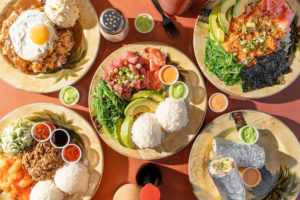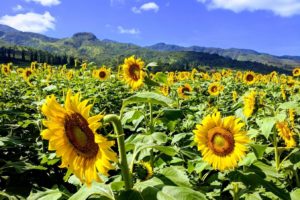To residents it’s simply “the hill.”
To visitors, it’s an excursion into a tropical jungle.
Puʻuohiʻa, better known as Tantalus mountain, is both and more: hikers’ heaven, botanical paradise, cyclists’ and runners’ proving ground, a bird-watcher’s delight.
This stately guardian to the Koʻolau range offers the best views, the best trails and, during summer months especially, metropolitan Honolulu’s backyard rain forest is an easy escape by car from the heated sidewalks and high-rises of the city
Few places on Oahu retain the mystique of this close-knit mountain community, with its gracious old kamaʻaina houses and estates hidden by a topography that favors privacy.
Turn onto Round Top Drive (which connects with Tantalus Drive) and there are driveways at seeming impossible inclines, rooftops that emerge level with your car wheels, sheer drops into canyons many feet below, and unbeatable views across the city.
A canopy of kukui and banyan trees shades the mountain’s single road — a two-lane, 10-mile loop with a series of hairpin turns and blind corners that challenge even the smallest of cars.
Mongooses race fearlessly across the road, the melodic calls of shama thrush echo from trees swathed in giant philodendron leaves. It’s cool, peaceful and woodsy — and frequently wet. Though not strictly classified a rain forest, the rainfall at the summit of Tantalus, measures more than 160 inches annually, a tad wetter than the 20 inches recorded at nearby Waikiki.
At the “Hog’s Back” lookout, a razorback summit ridge where the road narrows to a single lane, views take in two major valleys: on the Waiʻanae side is Pauoa Flats, part of Nuʻuanu valley and toward Diamond Head is Manoa, the two valleys bridged by a panorama from Kalaeloa to Diamond Head Crater.
Giving the mountain its lushness are rare Hawaiian plants, an astonishing assortment of trees, fast-encroaching bamboo forests and beautiful flowers. Also, wild coffee plants, guavas, thimbleberries and mountain apples. Maidenhead ferns spring from Tantalus ash banks. Bordering Round Top Drive is exotic and fragrant night-blooming cereus.
Puʻuohiʻa was called Tantalus after the Greek god by Punahou schoolboys on a fern-collecting expedition in the 1840s. The mountain is home to a small community with its own telephone directory whose octogenarians walk daily to help clear roadside trash.
But there’s a dark side, too, famously referred to as Tantalus’ “hankery pankery.” Bodies and bones turn up from time to time in the undergrowth. The mountain is secluded, dark and quiet at night, harboring secrets to crimes as yet unsolved.
Though little in the way of a formal history is written about Tantalus, memories and stories from longtime residents paint a picture of the mountain in the last century as an Eden-like place. A time when Tantalus was “country,” and well-to-do Honolulu families owned a place in the country, as well as the city.
The first house is believed to have been built in the 1880s, a small cabin on the slope of the Punchbowl side. In the early days of homesteading at the beginning of the 20th century, summer houses and cabins were built as mountain retreats to escape the season’s heat. Roads were built and maintained by prisoners from Oahu prison, little more than trails of volcanic gravel excavated from nearby Makiki quarries.
House-building materials were hauled by horse and wagon or human effort up the mountain’s only road from Punchbowl side. According to early accounts, even when cars began making the journey around 1914, they frequently overheated and broke down, resenting the single, long winding path.
Homes were lit by kerosene lamps. Water then as now was collected in massive redwood rain tanks. Electricity arrived on the mountain in the mid-1920s. Few homes had telephones, and those that did shared with those who did not.
Today fewer than 200 homes exist off Round Top/Tantalus Drive. Most began as small summer houses with corrugated roofs, built for well-known families, among them the Dillinghams, Castles, Bishops, Isenbergs and Wilders. The homes were later expanded and improved or rebuilt into today’s upscale structures.
Several were designed by architects Charles Dickey and Hart Wood. Some families designed and built their own properties, with younger generations adding to them over the years.








